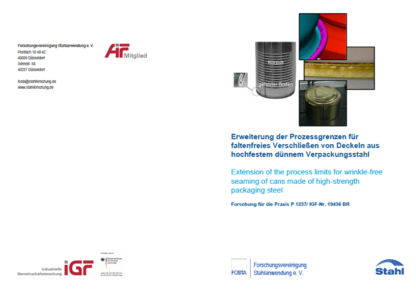Description
P 1237 – Extension of the process limits for wrinkle-free seaming of cans made of high-strength packaging steel
With the background of constantly decreasing resources and very high production vol-umes in the billions, the topic of material savings is of central importance in the packag-ing steel industry. The entire packaging steel industry is faced with the economic and technical challenge of having to process higher-strength tinplate alloys in a reliable man-ner. Within the scope of this research project, it was investigated to what extent thinner, higher-strength metal packaging materials can be processed reliably with the seaming technology in particular for three-piece food cans.
Based on extensive literature research on the state of the art of seaming technology for metal packaging and the expert discussion (interviews) within the industrial working group accompanying the project, the main influences on the seaming process have been detailed and evaluated.
With help of an FEM process model for the roll-seaming technology, the main influences were analyzed and subsequently an optimization for the essential parameters was car-ried out. Based on a new criterion for the wrinkle assessment (waviness and max. wrin-kle height) in the FEM results, comparability could be established and evaluated. Within the process optimization, especially the profile geometry of the seaming roller OP1 was changed. The profile height and the profile radii turned out to be the main influences. The values for these parameters achieved within the optimization showed a significantly better wrinkle behavior in the FEM model and were subsequently tested in experimental trials on industrial machines.
Within the experimental investigations at three different machine manufacturers and one canmaker the improvement of the wrinkling with the new tool geometries for the seaming operation OP1 could be practically proven. The cans produced by the industrial partici-pants were given in small quantities to the industrial measuring partner, who analyzed those with regard to wrinkle formation using a new non-destructive measuring principle. In the analysis of the results for all the materials investigated, it was possible to prove that with the optimized process parameters and tool geometries, a significant improve-ment in wrinkle formation occurs for all manufacturers.
Within the investigations on the functionality of the seamed cans, the buckling test was carried out. From a small quantity sample, it can be concluded that all materials with a higher strength have the potential for functional improvement. However, it can also be stated that materials with a high strength and a high elongation have a greater potential for improving the functionality of the can than materials with a pure strength increase.
Main content only available in german language.
Published in:
August 2020
Authors:
Prof. Dr.-Ing. W.-G. Drossel
Dipl.-Ing. T. Lieber
Dipl.-Ing. Dipl.-Wirtsch.-Ing. M. Nagel




